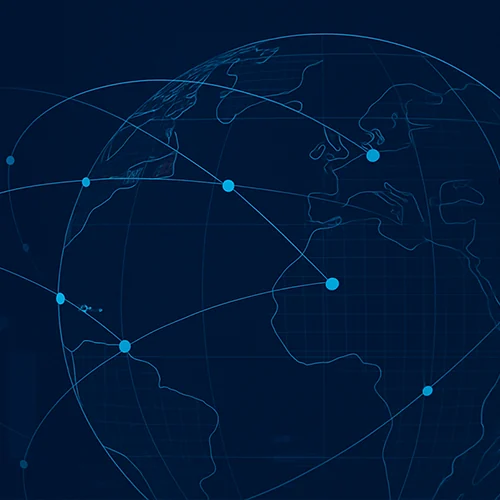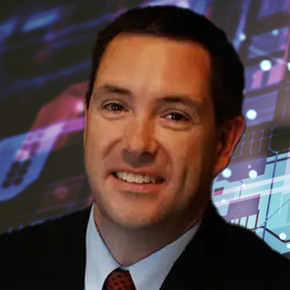December 2, 2024
The 2 Biggest Challenges Facing Manufacturing in 2025

Transcript
How Does Today’s Economy Affect Manufacturing?
In this moment, manufacturers are facing pressure from all sides:
- Inflation
- Labor shortages
- Fluctuating materials prices
- Uncertainty about the future of tariffs
- All impacting decisions for offshoring or nearshoring
This is a perfect moment, in other words, to reconsider strategy and make sure you have the insights you need to make crucial strategic decisions about your manufacturing operations.
To learn how today’s forward-thinking manufacturers are staying ahead with the information they need to mitigate risk and keep a lid on costs, we are hearing today from someone who spends her life talking to and helping top worldwide manufacturers — the CEO of aPriori Technologies, Stephanie Feraday. This conversation is hosted by the leader of our exec talk series, Chris Jeznach, the Senior Director of Product Marketing at aPriori, and a strategic thinker in the ways that market dynamics impact the problems facing manufacturers today.
Economic Downturns of the Past Predict Success For Companies that Embrace Change Today
Chris Jeznach: Stephanie, you’ve been CEO at aPriori for nearly 17 years. Where did aPriori start when you first joined in?
Stephanie Feraday: When I started it was 2009, which was a terrible time to be in the manufacturing industry. It was the heart of the downturn, and the reason I was so excited to join was because of the solution that aPriori was building, all around generating insights for manufacturers to make better decisions. At that time it was around cost. Now, subsequently, we’ve gone on to generate manufacturability insights, as well as sustainability insights — a lot of information about manufacturing. But in 2009, it was around cost, and at that time, we had less than a dozen manufacturing simulations, which was about 25% of the overall market. With that said, though, the companies that we were working with — and in essence they were companies that generated products with thick sheet metal — were getting tremendous value. So even though it was a small portion of the market, we were proving that what we were doing was having an impact and a significant impact.
Fast forward to where we are today. aPriori has expanded manufacturing simulations, increasing the number of CAD platforms that we support, and integrating with all of the major PLM systems. Today we support all the major PLM and CAD systems. We have almost 500 manufacturing simulations. We have data libraries that support our manufacturing simulations to generate insights from all different regions of the world, across different manufacturing processes with different volumes and different materials. And we offer those insights up in a way that the different people can better understand them — to enable sourcing, manufacturing, and engineering to use these insights to do their jobs better.
Chris Jeznach: As CEO, I’m sure there are a lot of proud moments for you with what aPriori has accomplished. What has stood out for you in terms of one of the most significant impacts?
Stephanie Feraday: The number one thing has to be the impact that we have on our customers. It’s the return on investment that we generate for our customers, and that was one of the things that really attracted me to aPriori right from the beginning.
The Impact of aPriori Insights:
- Reducing the cost of goods sold
- Accelerating time to market
- Enabling teams to quote faster and more accurately
Stephanie Feraday: Whether it’s increasing top-line revenue, reducing costs of goods, or accelerating time to market, aPriori is having a quantifiable impact on their business. I’ve worked in technology for a long time, and we’ve always generated ROI, but at aPriori, we have a very hard quantifiable ROI, and it’s very clear to see the impact we have on manufacturers’ business. So that’s the thing that makes me most proud, because I can engage with a customer and I can see what we’re doing for them.
Chris Jeznach: You talk to a lot of executives at global manufacturing companies, and I’m sure you’re hearing directly about what they care about, what they’re investing in, and what’s the next big project that they’re looking to improve. What are some of those themes that you’re hearing from global manufacturing executives? What’s top of mind for the outcomes they’re looking to drive in 2025?
The 2 Biggest Challenges Facing Manufacturing Executives
Stephanie Feraday: The two biggest challenges that I hear companies facing today are competition and cost.
1) Competition
Stephanie Feraday: First are competitive challenges. If you think about the competitive landscape for manufacturing, that’s changed a lot over the last many years. It used to be GM competing with Ford competing with Stellantis. Well, now they’re competing with global competitors coming from other regions of the world like China. So the competitive landscape has become very different in that you’re competing with players who didn’t use to compete in your marketplace, and that’s making it much more challenging because they operate at a different speed.
We’ve had examples from our customers where they might take a few weeks to do a quote, while their Chinese competitors do it in five days. Now, they need to operate at what they call “China speed.” So, the ability to operate faster in today’s market is critical.
On top of that, you have entrants — you might think of them as manufacturing startups. If you went back 20 years ago, would you have ever thought there could be a Tesla on the market or a Waymo or a SpaceX or a Blue Origin? People would’ve laughed and said, “No way.” That seems like an oxymoron 20 years ago, but it’s certainly not the case today. So companies are having to look at doing things differently.
You hear a lot of conversations about the digital twin, the digital thread, digital manufacturing, and digital prototyping. That has to happen to address today’s competitive challenges because so much of it is around speed.
2) Cost
Stephanie Feraday: The other part that I hear all over the place is cost. The macroeconomic challenges in today’s market are creating significant cost challenges. If you look at the PMI numbers that came out from the ISM, manufacturing is in a challenging market right now. Inflation has created challenges in terms of being able to invest to drive new product programs. But the traditional cost challenges that have faced manufacturers still proliferate, whether it’s labor rates going up because of scarce resources, and you need these skilled resources, so you have to pay more. Or it could be material prices; copper prices are all over the map. And then with the elections just concluding, people are unsure about what’s going to happen with tariffs.
So getting their arms around cost, trying to ensure that they’re going to hit the margin goals that they’ve set at the beginning of a program, is essential. When a product design cycle might take 18-24 months, there are lots of things that can happen during that 18-24 month period that you have to continually factor in. And unless you have a way to do that in real-time, it creates real challenges to meet the cost. And then circling back to the competitive landscape, it makes competing with these new players even more challenging.
How Top Companies Turn Competition and Cost to Their Advantage
Chris Jeznach: We talked about what you’ve been hearing from executives in terms of competition and cost. What have you seen companies put in place to make sure that they stay on track to handle these challenges?
Stephanie Feraday: Companies have to embrace change. You can’t be afraid to change your processes if you want to achieve business outcomes. We’re seeing companies that were tentative to change facing the same issues that they faced last year.
If you think back to technologies that can drive fundamental change, whether it’s aPriori or other types of technologies such as model-based definition or digital transformation, unless you drive process change, you’re not going to be successful with those programs. The companies that do drive change are the ones we see achieve significant outcomes. They’re changing processes: driven from the top-down, but enabled by the bottom-up. And those companies are achieving the significant ROI that I just referenced.
Chris Jeznach: You talked about some of the ROI you’ve seen with aPriori’s customers. Could you just put that in perspective? Are there any numbers you could share of what they’re able to achieve?
Stephanie Feraday: Different use cases have different returns on investments, but if you think about fact-based negotiation or supplier collaboration where you’re buying things and you need to achieve a different cost outcome, that’s in the millions or tens of millions of dollars. Really, $10, $20, or $30 million isn’t unheard of. It’s because they’re able to understand what’s driving the cost and how they can both achieve a better outcome.
We had one example with a customer where the cost wasn’t where they needed it to be. Using aPriori, they were able to go to the supplier and instead of talking about cost, they asked the supplier about what manufacturing processes were in use and what were the routings. Through that conversation, they uncovered that there were things the supplier was doing that they didn’t need them to do. So, the supplier achieved a great outcome with preserving their margin, and the manufacturer got a better cost outcome. That’s a great example of how aPriori helps save on supply chain costs without damaging supplier relationships.
On the engineering side, the cost savings are more around cost avoidance and time to market. And that’s where the magnitude can be huge because you’re taking costs out before you’ve incurred them. In design engineering, when you quantify the time-to-market savings of reducing engineering change orders, the impact is huge. We’ve had customers quantify that for every ECO, it can cost between $1-$3 million. And they don’t just have one, they have multiples, which delays time to revenue because you’re having to go back and make these changes. And it’s increasing the cost because you’re tying up these teams for longer. But on top of that, there’s also the opportunity cost that’s lost because those teams can’t go onto new programs. So the impact can be significant.
On the manufacturing team’s side, the ROI can be seen through increasing factory utilization. Or we can help them understand what products are the best to manufacture given their internal capabilities, increasing their utilization, and making better use of the cost that they’ve invested in their plants.
Chris Jeznach: How does aPriori help address these challenges?
Stephanie Feraday: The aPriori platform with manufacturing insights, sustainability insights, and cost insights, lets our users to be able to make decisions in seconds rather than the days or weeks that it used to take. That enables sourcing teams, design engineering teams, and manufacturing teams to make decisions much faster, or maybe even make decisions that they couldn’t make before because of time. If you think about a design engineer, he’s not standing still waiting for feedback. He’s making changes to his design day in and day out. If a few days go by, or a week goes by, and he finally gets some feedback on design for manufacturability, now his design is in a completely different place. So giving people the information they need at the moment they need it is the first thing.
The second thing is that because these insights can be shared across the organization, you can compound that benefit. So for example, if design engineers are using our technology and getting insights on manufacturability and other issues, the sourcing teams can get early visibility into what’s coming down the product pipeline. That enables them to start looking at what manufacturing capabilities they are going to need earlier, so they’re not scrambling at the end of the process and having to make very cost-ineffective decisions to get a supplier on board quickly.
But I think the final proof that gives people confidence in our solution is the wealth of case studies we have from our customers. The fact that our customers are willing to share the significant impact that we’ve had on their business shows the ROI they’re getting from aPriori.
How to Budget for Success in 2025’s Economy
Chris Jeznach: A lot of companies might be in the budgeting cycle right now, maybe thinking about what to invest in next year. If I’m an executive, maybe I’m considering my options to achieve faster product development times, like you talked about earlier, or maybe it’s reducing costs to have an impact on EBITDA. What advice can you give as someone who owns strategy? What should they consider in how to prioritize what to do next?
Stephanie Feraday: This is a tough market for a lot of companies, especially for manufacturing. The macroeconomic situation is having an impact. We’re seeing software budgets decrease, and so companies are getting more frugal in how they spend their money — pulling back. But I have to say, this isn’t a market to be timid. This is a market where people have to do things that will make a difference. You can’t just continue to do the same old, same old, otherwise in the next few years, you may find yourself in a worse position than you are now.
Let me give you an example that goes back to when I first started here. It was during the 2009 financial crisis, and we were working with a $3 billion manufacturer, who did something very interesting. Rather than cutting aPriori out of the budget, they realized the value that we were having on their business. So instead of reducing, they actually expanded. And what they did was they used that expansion to find savings that enabled them to fund a team that they were going to have to cut. So when they came out of the economic downturn, they were actually ahead of the competition because they had these new additional products coming out. That’s the kind of bold decision that shifted their position to be more competitive.
It’s going to take people getting uncomfortable and making these bold decisions so that they can be in a different position at the end of the downturn.
Chris Jeznach: That makes a lot of sense. What I’m hearing is that companies really need to be bold to take that next step to leap ahead in 2025.
Stephanie Feraday: Yes. Now is the time that companies have to think differently and do differently to be able to change the trajectory that they’re on. Especially if they’re in a world that isn’t improving. They have to think of ways to make the future different.







